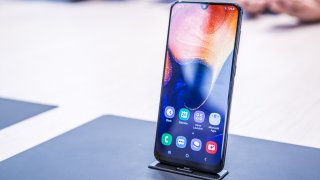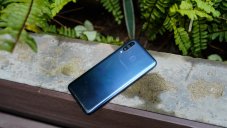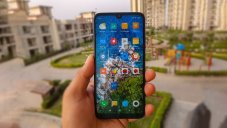Samsung Galaxy M30
$112 | 9999
- 6.4" 1080x2340 pixels
- 13MP 1080p
- 3-6GB RAM Exynos 7904
- 5000mAh Li-Po
Phone Finder
- Acer alcatel Allview Amazon Amoi Apple Archos Asus AT&T Benefon BenQ BenQ-Siemens Bird BlackBerry Blackview BLU Bosch BQ Casio Cat Celkon Chea Coolpad Cubot Dell Doogee Emporia Energizer Ericsson Eten Fairphone Fujitsu Siemens Garmin-Asus Gigabyte Gionee Google Haier HMD Honor HP HTC Huawei i-mate i-mobile Icemobile Infinix Innostream iNQ Intex itel Jolla Karbonn Kyocera Lava LeEco Lenovo LG Maxon Maxwest Meizu Micromax Microsoft Mitac Mitsubishi Modu Motorola MWg NEC Neonode NIU Nokia Nothing Nvidia O2 OnePlus Oppo Orange Oscal Oukitel Palm Panasonic Pantech Parla Philips Plum Posh Prestigio QMobile Qtek Razer Realme Sagem Samsung Sendo Sewon Sharp Siemens Sonim Sony Sony Ericsson Spice T-Mobile TCL Tecno Tel.Me. Telit Thuraya Toshiba Ulefone Umidigi Unnecto Vertu verykool vivo VK Mobile Vodafone Wiko WND XCute Xiaomi XOLO Yezz Yota YU ZTE
Samsung Galaxy M30 Summary
Samsung this year focused all its resources on the A series and two high-end series, the Galaxy S and Note. However, the company still launched a few M series products aimed at users who want a smartphone that meets the basic needs at a reasonable price.
The Galaxy M30 just sold in mid-August in India for Rs. 10,399. This is an upgrade of the Galaxy M20 launched exactly half a year ago. Compared to the Galaxy M20, this product has 4 most significant upgrades: switching to AMOLED panel, an extra camera for portrait shot, a front camera with twice the resolution to 16MP, and increased internal storage.
In addition, the Galaxy M30 still retains the Exynos 7904 processor with 5,000 mAh battery capacity that supports fast charging similar to its predecessor. The overall design hasn't changed much either.
Samsung Galaxy M30: Display
The Galaxy M30 is the only product in the M series to get an AMOLED panel. The display has a size of 6.39 inches, Full-HD+ resolution, 19.5:9 aspect ratio, and a pixel density of 403 PPI.
The screen of the Galaxy M30 has a high maximum brightness, which is enough for comfortable use and easy to see in the sun. Like many other Samsung devices, the maximum brightness of this screen reaches the highest peak in auto brightness mode, much higher than in manual mode. So when using under direct sunlight, you should switch to automatic brightness adjustment for clearer viewing.
In addition to the high brightness, the screen also has the characteristic bright colors and wide viewing angle of an AMOLED panel. Compared with the Galaxy M20, the Galaxy M30's screen is fresher and has a slightly higher maximum brightness. However, the difference in overall is not much. In fact, LCD screens on mid-range smartphones recently have improved in quality, not much different from AMOLED screens like a few years ago.
Samsung Galaxy M30: Performance
Performance is where Galaxy M30 doesn’t differ from the old series. It is still equipped with the Exynos 7904 chipset manufactured on 14nm FinFET process, which has 2 high-performance Cortex-A73 cores clocked at 1.8GHz and 6 Cortex-A53 power-saving cores clocked at 1.6GHz with Mali-G71 MP2 GPU. However, the memory (RAM and storage) has been increased on the base model, 4GB RAM and 64GB internal storage compared to 3GB RAM + 32GB storage on the base version of Galaxy M20.
In terms of power, the Galaxy M30's Exynos 7904 chip is inferior to many products of the same price range today using Snapdragon 710 processor (Realme 3 Pro), Kirin 710 (Huawei P30 Lite), Helio P65 (Vivo S1 ) or Helio P70 (Oppo F11). This is clearly shown in the performance scores on standard benchmark software.
The Galaxy M30 can stably handle basic tasks such as surfing the web, listening to music, watching YouTube or taking pictures. The device is also powerful enough to play light popular games, but for games that require a lot of graphics processing power such as PUBG Mobile or Warhammer 40,000: Freeblade, the device struggles with low fps and stability.
In general, the performance of the Galaxy M30 is only enough for casual use, not suitable for gaming. If you want to play games or use a lot of heavy applications then you should consider other products equipped with Snapdragon 660, Snapdragon 710 or Helio P65 or P70 chips as mentioned above.
In terms of software, Galaxy A30 currently comes pre-installed with customized One UI 1.1 based on Android 9. The interface and software functions of the device are similar to those of Galaxy A products in 2019.
Samsung Galaxy M30: Battery life
Unsurprisingly, the massive 5,000 mAh battery and the energy-efficient AMOLED display have brought very good actual battery life to the Galaxy M30. In our regular battery tests, this phone has the top notch battery life in the current mid-range segment, much higher than the Asus Zenfone Max Pro M2 with the same 5,000 mAh capacity.
Galaxy M30 supports 15W fast charging and comes with 9V / 1.67A fast charger. Using the included charger, the device was fully charged in about 2 hours and 15 minutes, of which the first 30 minutes charged 25% and 1 hour charged nearly half the battery.
Samsung Galaxy M30: Camera
The triple camera cluster on the Galaxy M30 includes a 13MP main sensor with an aperture of f/1.9, a 5MP portrait camera, and a 5MP ultra-wide-angle camera with a 123-degree viewing angle. The camera specs of the Galaxy M30 are pretty much the same as its predecessor, except for the addition of the 5MP portrait camera.
You can take landscape photos with the M30’s wide-angle camera, but you should not expect high-quality ones. In day-light scenes, the device can take serviceable photos, though you might notice the lack of fine detail in the photos.
Indoors, even if you take photos with enough light, the M30 won’t make you happy.
Indoors, even in bright light, the Galaxy M30 doesn’t fare all that well. There is significant noise in the shadow regions and the image generally appears a bit blown out. Zooming in reveals a watercolor-like noise reduction effect.
The 16MP front-facing camera takes average images. The phone can manage Full HD video recording on both the front and the back camera. Unfortunately, there is no form of video stabilization available.
Samsung Galaxy M30: Verdict
Equipping with an AMOLED screen has affected many factors on Galaxy M30. Not only improving display quality, but the power-saving AMOLED screen also helps this phone have top battery life in the current mid-range segment while also contributing to the slim body lighter than the old devices that use the LCD screen.
Performance is the point that the Galaxy M30 struggles. The camera quality is also not better than competing products. So, overall, the Galaxy M30 is suitable for those who want a massive battery smartphone and a quality display for web surfing and normal use, without the need to play heavy games.
Samsung Galaxy M30 Full Specifications
- Dollas $112 Buy in Flipkart >
- Rupee ₹9999 Buy in Flipkart >
- Technology GSM / HSPA / LTE
- 2G bands GSM 850 / 900 / 1800 / 1900 - SIM 1 & SIM 2
- 3G bands HSDPA 850 / 900 / 1900 / 2100
- 4G bands 1, 3, 5, 8, 20, 40, 41
- Speed HSPA, LTE-A
- Announced 2019, February
- Status Available. Released 2019, March
- Dimensions 159 x 75.1 x 8.5 mm (6.26 x 2.96 x 0.33 in)
- Weight 174 g (6.14 oz)
- Build Glass front, plastic back, plastic frame
- SIM Dual SIM (Nano-SIM, dual stand-by)
- Type Super AMOLED capacitive touchscreen, 16M colors
- Size 6.4 inches, 100.5 cm2 (~84.2% screen-to-body ratio)
- Resolution 1080 x 2340 pixels, 19.5:9 ratio (~403 ppi density)
- OS Android 8.1 (Oreo), upgradable to Android 10.0; One UI 2
- Chipset Exynos 7904 (14 nm)
- CPU Octa-core (2x1.8 GHz Cortex-A73 & 6x1.6 GHz Cortex-A53)
- GPU Mali-G71 MP2
- Card slot microSDXC (dedicated slot)
- Internal 32GB 3GB RAM, 64GB 4GB RAM, 128GB 6GB RAM
- eMMC 5.1
- Modules 13 MP, f/1.9, PDAF 5 MP, f/2.2, 12mm (ultrawide) 5 MP, f/2.2, (depth)
- Features LED flash, panorama, HDR
- Video 1080p@30fps
- Modules 16 MP, f/2.0, 26mm (wide), 1/3.1", 1.0µm
- Features HDR
- Video 1080p@30fps
- Loudspeaker Yes
- 3.5mm jack Yes
- WLAN Wi-Fi 802.11 a/b/g/n/ac, dual-band, Wi-Fi Direct, hotspot
- Bluetooth 5.0, A2DP, LE
- GPS Yes, with A-GPS, GLONASS, BDS
- Radio FM radio, RDS, recording
- USB 2.0, Type-C 1.0 reversible connector
- Sensors Fingerprint (rear-mounted), accelerometer, gyro, proximity, compass
- Non-removable Li-Po 5000 mAh battery
- Charging Fast charging 15W
- Colors Black, Blue
- Models SM-M305F, SM-M305FN, SM-M305G, SM-M305M, SM-A3051, SM-A3058, SM-A3050
- SAR 0.28 W/kg (head) 0.39 W/kg (body)
- SAR EU 0.45 W/kg (head) 1.32 W/kg (body)
- Performance AnTuTu: 101651 (v7) GeekBench: 4188 (v4.4) GFXBench: 4.6fps (ES 3.1 onscreen)
- Display Contrast ratio: Infinite (nominal)
- Camera Photo
- Loudspeaker Voice 65dB / Noise 66dB / Ring 70dB
- Audio quality Noise -90.5dB / Crosstalk -90.0dB
- Battery life Endurance rating 119h
Samsung Galaxy M30 News

Mobile - Feb 24, 2021
Samsung M30 Price In India: Samsung’s Mid-Range Phone For Millennials

Review - Feb 17, 2021
Samsung Galaxy M30 Review: An Affordable & Reliable Daily Driver

Review - May 25, 2020
Best Phone Low Price: Top Options For Budget-Conscious Indians

Mobile - Jul 22, 2019
Our Picks Of The Best Phone To Buy Under 15000, Updated List For 2019

Mobile - Apr 30, 2019











